I think maybe Black Ice has made it impossible to allow the AI control of your units. Player control would probably give somewhat better results.
Doppelgänger: the Untold Story of the Third Reich
- Thread starter Uriah
- Start date
-
We have updated our Community Code of Conduct. Please read through the new rules for the forum that are an integral part of Paradox Interactive’s User Agreement.
You are using an out of date browser. It may not display this or other websites correctly.
You should upgrade or use an alternative browser.
You should upgrade or use an alternative browser.
Bringing the Gebirgsjagers west is probably a good idea, but I didn't do it and am now playing in March. Possible breach of the Soviet NA Pact starts in July. I really don't want to fight on two fronts, so they can stay there for now.
This will be a tough fight. No easy wins for me.
Still time to exchange your garrison forces then, send the militia east and the engineers west, or just send the engineering brigades west.
I think maybe Black Ice has made it impossible to allow the AI control of your units. Player control would probably give somewhat better results.
Then this wouldn't be as interesting! its easy as a human to overrun the AI even with bad division composition.
I think maybe Black Ice has made it impossible to allow the AI control of your units. Player control would probably give somewhat better results.
I am sure player control would make it easy: the weight of amour and mot troops I have in 1st PzA is plenty to smash a three province hole. But it is too easy and too unrealistic for me. I like the struggle to find the right orders to get my temperatmental generals to do the right thing.
Still time to exchange your garrison forces then, send the militia east and the engineers west, or just send the engineering brigades west.
There is time I suppose, but I am sure I can win the west with what I have got. Losses are a bit high, but that is mainly because of a couple of bad losses which involved rubbish SS units. I still have more than 1,900 MP though, and my plan is to keep losses down. Time is a bit of an issue, as I had hoped to be well on the way to the coast by now. Still, the overall aim is to defeat France in 1940, and that is still on track. Again, I had hoped to be in a postion to at least consider taking Spain, but that now seems to tough. Maybe Romania.
I am also seriously considering post-poning Barbarossa until I can build a bigger army. Risky (the USSR builds too) but it may be less fangerous than attacking with maybe only another 20-25 divs than I have now.
Then this wouldn't be as interesting! its easy as a human to overrun the AI even with bad division composition.
My division compostion is not bad!! :unsure: Or at least not totally bad. Just designed for another mod. With the expansion of CA it is now worthwhile to drop to two INF. I just didn't think it through. For years I have relied on the weight of my three INF divs to eirher smash through or hold off the enemy.
Now I must change. At least you all get to see how it leaves you with too small an army.
But if plans always work perfectly, there is no fun. Glusckslee is just a plan, not cast in stone. My generals must be prepared for Rotsklee II
Will you restructure your army to INF, INF in preparation for Barbarossa?For years I have relied on the weight of my three INF divs to eirher smash through or hold off the enemy.
I actually did somewhat the same in my current campaign (first time TFH) going INF, INF, INF, ART as I always have... Quite oblivious to the fine information presented in the interface
Immediately after Poland I restructured my army to INF, INF, ART - with the intention to add an AT for Barbarossa.
This being my first TFH game, I don't play with any mods. I also have AI at Army level - except my zbV (special purpose - mostly marines and paratroopers). I control the navy though.
With our playstyles being similar, I'm learning from your mistakes, so please keep informing us - it's greatly appreciated!
Will you restructure your army to INF, INF in preparation for Barbarossa?
I actually did somewhat the same in my current campaign (first time TFH) going INF, INF, INF, ART as I always have... Quite oblivious to the fine information presented in the interface
Immediately after Poland I restructured my army to INF, INF, ART - with the intention to add an AT for Barbarossa.
This being my first TFH game, I don't play with any mods. I also have AI at Army level - except my zbV (special purpose - mostly marines and paratroopers). I control the navy though.
With our playstyles being similar, I'm learning from your mistakes, so please keep informing us - it's greatly appreciated!
Glad to see my mistakes are helping someone.
I have started building groups of 3 x AA, 1 x ART. By adding these to two existing 3 x INF, ART Divs, I will have 6 x INF, 3 x ART, 3 x AA That will allow me to form 3 [2INF, ART, AA] So I will increase my number of divs by 50% for relatively low cost.
Don't use an AT - it is in the same group as ART so you won't get a Combined Arms bonus.
I too keep marines and paras as independents, though if they are thrown into general fighting I always attach them to a Korps. This is the first game I have played iwth ships attached to armies. The subs are individually controlled - the AI isn't too good with them. (IMHO - please let me know if anyone feels the AI can handle dub warfare).
PS I sometimes keep an independent SS Cavalry or two in occupied lands: just to run around "reoccupying" provinces after rebellions have been crushed. The AI ignores them.
Doppelgänger: the Untold Story of the Third Reich
With his feet up, relaxing in an armchair, a man is sitting in a small sitting room in an apartment close to Wilhemstraße. Hanging on the back of the door is a military uniform, looking freshly pressed, as if it has just come back from the cleaners. The man is looking at a large map which he has spread on his lap.
A couple of police detachments have been sent to Poland to help keep the peace. With so few troops in the east, and those mainly within a few kilometres of the border with the USSR, we need to suppress any insurrection before it starts.
General von Manstein was keen to suppress insurrection, in the form of the French troops moving into previously conquered Steenwijk. He called upon his best unit, Infantry Regiment “Groß Deutschland” to take it back. Agricola would not find this easy, but then IRGD is never given the easy jobs.
The Führer called an urgent Cabinet meeting early in the morning, concerned about the lack of progress in the west. After giving all the ministers a reminder that failure to produce results was treason against the state, he dropped his bombshell – he would be going to the front to encourage the troops. He would be risking his life for the good of the Reich: he expected his ministers to show a similar level of commitment. He was to leave immediately the meeting ended, flying to Bitburg.
Of course it wouldn’t be the Führer heading into danger: I was already at Tempelhof, waiting for the call to board “Immelman II”. Within minutes of the end of the Cabinet meeting, the aircraft was in the air. A three hour flight and I was landing at Bitburg airfield. As we approached I could see below a scene of frenetic activity. This was a combat airbase, home to Luftflotte II and III and Schlachtluftflotte I. A few planes were taking off and leaving, but the main impression was of tens of thousands of men scurrying around the hundreds of bombers scattered over the different runways.
After landing I was rushed to a secret and secure building where I was to remain until my performance the next day. Time to check up on events.
The Kriegsmarine had caused a slight alarm when it notified OKW that the Baltische Flotte had come under air attack off the coast of Holland. Memories of the recent naval battle that cost us the “Königsberg” but Admiral Raeder was quick to reassure everyone that Admiral Böhm had orders to pull back if detected. Raeder also reported our submarines had been in action, somewhere off the west coast of Ireland. Enable to penetrate the screen surrounding a convoy heading to Canada, von Arnauld de la Periere had to be satisfied with sinking a destroyer escort.
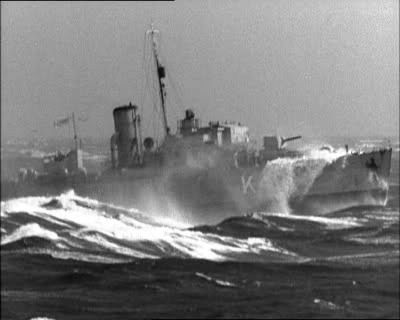
The unfortunate Kingfisher class corvette shortly before being hit by a torpedo from 1st Unterseebootsflotte.
At noon von Manstein was far happier. His trusted subordinate, Agricola, had not only retaken Steenwijk, he had delivered a sharp reminder to the French that we were not to be taken lightly. Although von Manstein obviously found that result to be important, the recapture of a province near the coast was nowhere near as significant as the defeat of the French in Dinant. Rommel had moved 1st Panzerarmee slightly further west. (A later French/Belgian probe into Dinant was easily brushed off).
With such a good start to the week, perhaps my appearance was not essential. Nevertheless, soon after dawn on Friday 26th I was picked up by a heavily armed convoy of vehicles. We headed northwest, through the heavily forested hills of Euskirchen and Aachen, to the woods of Maastricht. It was noticeable that my guards became more alert as we came within a few kilometres of the enemy, just across the Meuse or Maas, whatever you want to call the river that our men had to cross.
First there was a small ceremony at the headquarters of 35.ID. General Glokke, on behalf of his unit, accepted praise for its performance while being attacked by overwhelming forces back in December. From now it will be known as 35.ID “Aachen”. Then a short speech (distributed to the men of course) and I was escorted to a small knoll next to the path west, from which I could salute as a battalion moved off to the attack of Hasselt.

An official photograph of the event: an expert might be able to detect the imposter, but still nobody suspects.
That morning three battles were started: Hasselt, Amersfoort and Turnhout. Turnhout was over by the time I landed back in Berlin. General Behlendorff had achieved a great win, defeating four Belgian divisions in less than a day. He reported that captured soldiers, even from such elite units as the 1ére Chasseurs Ardennais, were exhausted and hungry. Is the Belgian Army on the verge of collapse or is this an isolated group who missed out on supplies? Needless to say, many in OKH hoped it was the former.
On the 27th, General Agricola again showed why he was von Manstein’s choice when the going was tough. Still recovering from the recapture of Steenwijk, “Groß Deutschland” was subjected to a surprise Dutch assault. By immediately ordering a counter-attack, Agricola outwitted General Dames, who had relied on a straightforward attack.
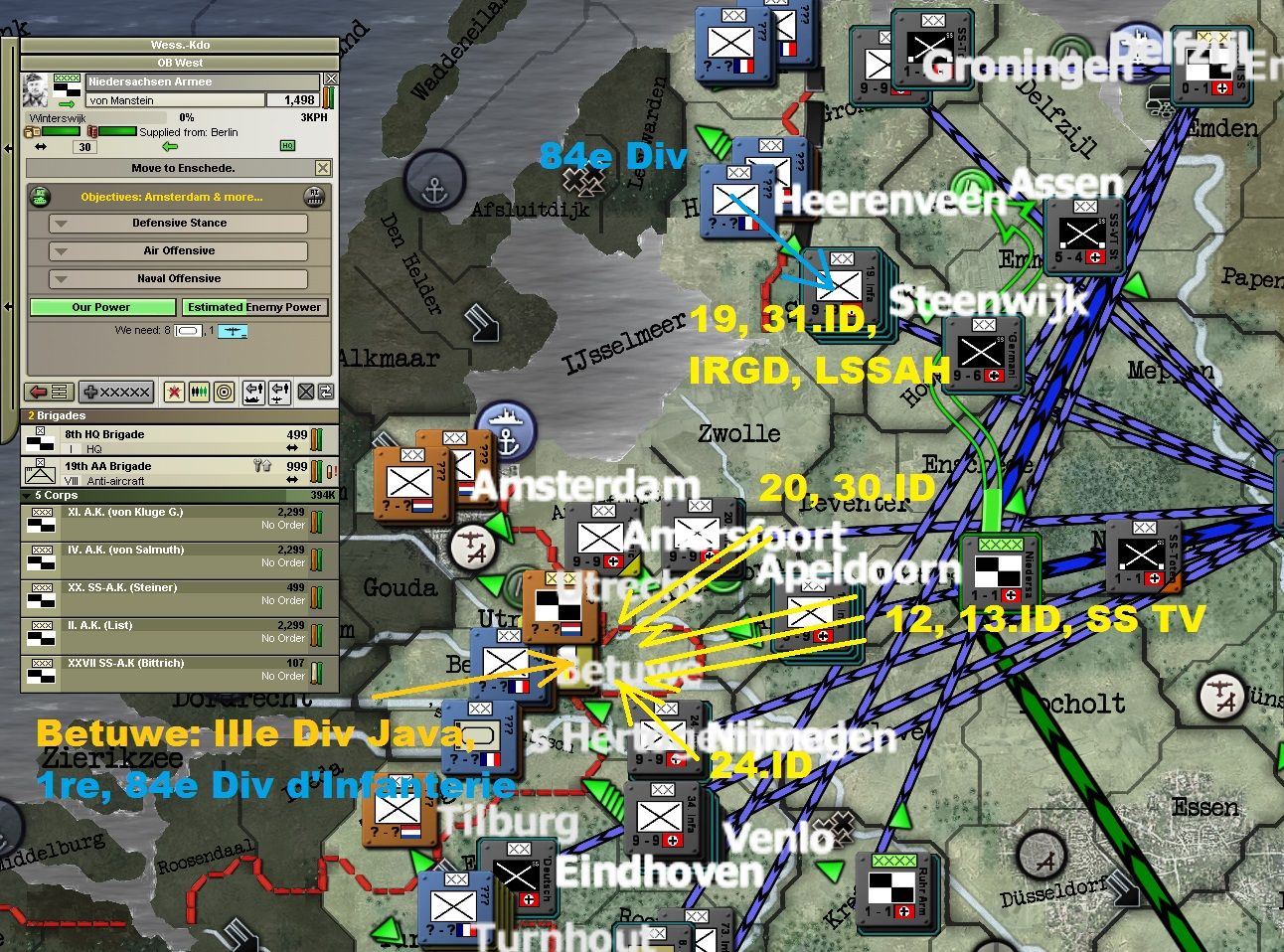
Niedersachsen Armee at end of January 1940
Behlendorff had to refight the Battle of Turnhout, though it shouldn’t be a problem. A semi-motorised Belgian unit used its speed to seize positions in front of 73.ID, but with a three to one advantage in numbers, Behlendorff has hardly slowed his advance.
My visit to the front (or the Führer’s, I suppose) had been very popular. The newspapers had loved it, it led the radio news and a short newsreel was being played at the cinemas. I even went and looked at it myself, having an evening off to go to the cinema. Ignoring Hippler’s “Der Westwall”, I paid to see the joint German/Italian production of “Marionette”. (I have had enough of Goebbel’s lightly camouflaged propaganda – a light comedy was far more to my liking).
I was very impressed with my performance in the newsreel preceding the film, though the voice-over was a bit flamboyant. “Risking his life at every moment, the Führer insists on joining our brave soldiers on the front!” The film was definitely light: just a vehicle for the Italian Gigli to sing. The plot was simply ludicrous, but Carla Rust was as beautiful as ever. The cinema was packed, so it seems many other Berliners also sought a break from the war.
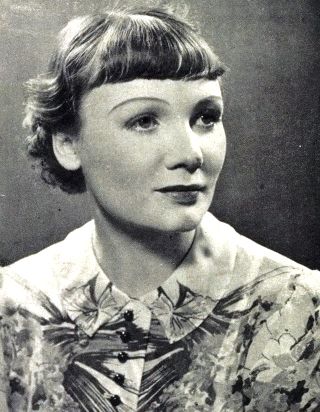
Carla Rust: I am sure she will be busy making escapist films for the next few years.
My night off left me refreshed, which was good as Sunday 28th started badly. Those young men I had saluted had returned from Hasselt, beaten by the Belgians. Some of them did not return: we lost nearly 900 men. The Belgians are obviously not all on the brink of collapse.
The next news was little better. Even though Sedan has been removed from the list of objectives for 1st Panzerarmee, Rommel must be fixated on the province, as General Neuling had led five divisions across the Meuse. Does he hope to emulate Moltke and win another decisive Battle of Sedan? If so, he is dreaming. The British General Adam is more astute than Napoleon III and the enemy are in much better shape than the besieged Army of Châlons.

Is this what Rommel has in mind: a repeat of 1870?
During the day it was air combat that dominated all conversations. The Allied airforces threw all they could at the Luftwaffe. Clashes occurred over Turnhout, Venlo, Tilburg, Breda and Rotterdam. Once again we suffered heavily. Many enemy aircraft were also destroyed but the Luftwaffe was cracking under the pressure. I made a couple of calls in my best Reichskanzler voice and soon every air unit in the west was given top priority for reinforcements.
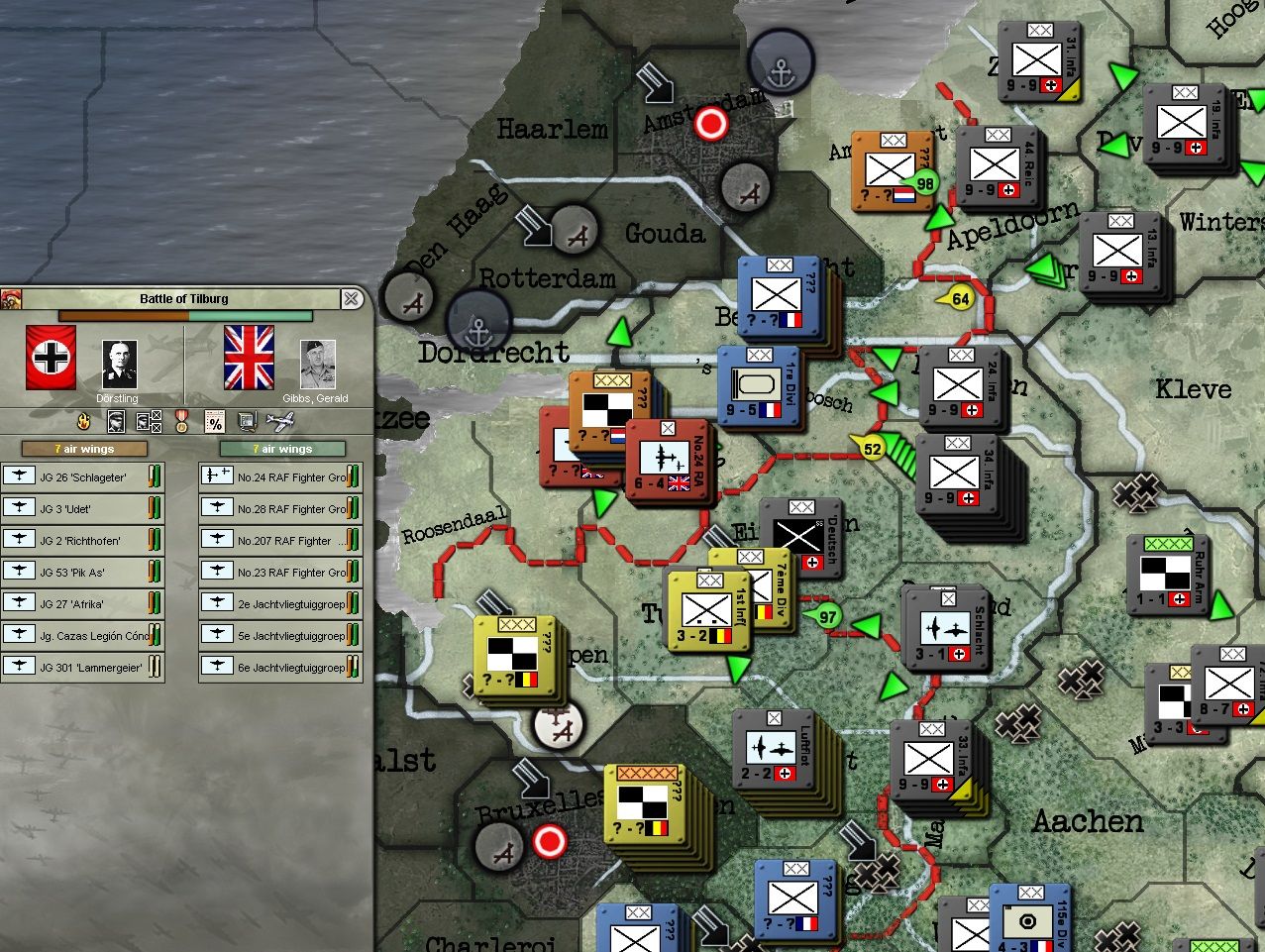
One of larger dogfights of the day took place over Tilburg at noon. Already some of our geschwader had been badly punished.
It may have been coincidence but as the Luftwaffe paid to keep the skies friendly, Bock von Wülfingen ended the Battle for Amersfoort. 44th Reichsgrenadier Division and its supporting units are now in a position to threaten Amsterdam itself.
Our factories, even at maximum capacity, cannot supply everything we need, let alone everything we want. Schacht has done wonders, but we still cannot produce all the new units on order, upgrade existing units, provide replacements for lost and damaged equipment and also manufacture all the military supplies the Wehrmacht consumes in vast quantities. A few more Polish provinces have new roads, but there is no more concrete and bitumen available for construction projects. Göring was delighted to get another geschwader of Heinkels (KG 27 “Boelcke”), which has been despatched to join Jeschonnek’s VIII Luftflotte. No more were ordered though Göring tried to bully the other ministers to support him. Someone had made sure that the Führer had details of our industrial capacity in front of him and Göring got nowhere. There was no spare factory space for more aircraft.

Fitting the wing on a new Heinkel: there is one more geschwader still under assembly
The next land action was early on the 30th, when the Dutch sent an exploratory probe into Amersfoort. It achieved little. Barely an hour later the probing force was heading the other way as 6.ID slowly moved back into contact in Hasselt. Things went fairly well and the probe has turned into another attempt to take the province.
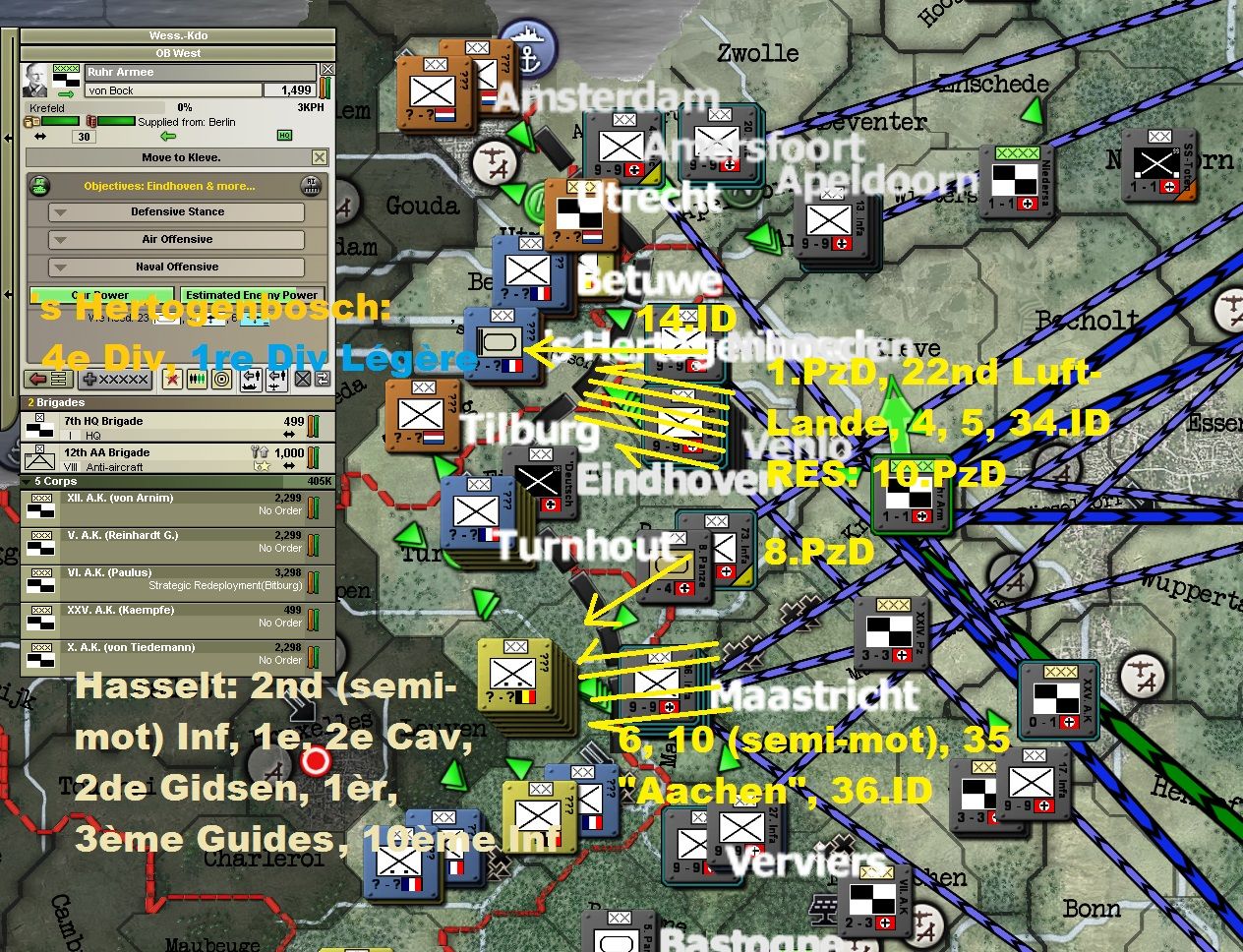
Ruhr Armee at the end of January 1940
With Rotklee seemingly hitting a brick wall, Rommel’s men stuck at the Meuse, unable to reach the perfect tank country just kilometres away, I have been pondering the alternatives. The Luftwaffe cannot inflict enough casualties to overwhelm the Allied reinforcements. Information from reconnaissance, both aerial and from our Aufklärungsabteilung, indicates a weakness in the enemy line in the Hasselt – Liège – Namur – Philippeville area. Perhaps a slight change in the schwerpunkt is all that is needed. I will keep a close watch on progress in Hasselt. If we can cross the Maas there, it may be worthwhile sending new orders.

1st Panzerarmee at end of January 1940
It is important to stay positive, to consider what opportunities we have rather than what problems we face. Staying positive is of course, easier when the news is good like that from Turnhout. Unassisted, 73.ID has beaten three enemy divisions. On that note I will end the month of January. I had hoped Rommel would be deep into France, but I must be satisfied with what we have achieved. Things could be worse. And there is that weak area in the enemy line on Rommel’s right flank ...

“The West” at the end of January 1940
With a sharp movement the man folds the map, rises, and leaves the room. He takes a heavy coat and a hat from a stand near the front door, wraps a scarf around his neck and heads out into the dark. Although it is gone 10PM and Berlin is cold, dark and mainly empty, he strides purposefully toward the Reichskanzlei, as though he were late for work.
Code:
[B][SIZE=4]Unternehmen Glückslee[/SIZE][/B]
[B]Finalised Battles for the period 25th to 31st January 1940[/B]
Steenswijk 24 (63,262) 633 (18,446) [F]
Dinant 202 (34,130) 607 (35,116) [F]
2nd Dinant 2 (16,748) 50 (26,488) [F25/B25]
Turnhout 59 (26,492) 183 (33,086) [B]
2nd Turnhout 205 (26,484) 1,104 (46,148) [F368/B736]
Hasselt 887 (114,933) 164 (49,983) [B]
Amersfoort 173 (80,937) 924 (14,990) [D]
2nd Amersfoort 1 (26,978) 3 (17,290) [D]
French 1,633
Belgian 1,108
Dutch 927
Total 1,553 3,668
[B]Bombing Summary for the period 25th to 31st January 1940[/B]
‘s Hertogenbosch Luftflotte IV 13, 23 [4F, 2D]
SLF I 15, Nil, 24
LF III 7, 24
Total 106 [F72/D34]
Dinant Schlachtluftflotte II 11 [F]
SLF I 40, 34 [F]
Total 86 [F]
Hasselt LF III 35, 30 [B]
LF II + SLF II 24, 57 [B]
LF II 17, 59, 35, 19 [B]
SLF I 20, 60 [B]
SLF I + V 80 [B]
Total 436 [B]
Turnhout LF VII 19, 56 [B]
SLF I 11, 33 [B]
Total 119 [B]
Sedan SLF II 10 [5UK, 8F, 2D]
SF II 42, 62
LF VII + SF II 23, 38, 68, 28, 37, 39
Total 347 [F185/D46/UK116]
French 343
Belgian 555
Dutch 80
British 116
Total 1,094
Unternhemen Glücksklee German Losses 1,553 (Ground) + Nil (Bombing) = 1,533
Unternehmen Glücksklee French Losses 1,633 + 343 = 1,976
Unternehmen Glücksklee Belgian Losses 1,108 + 555 = 1,663
Unternehmen Glücksklee Dutch Losses 927 + 80 = 1,007
Unternehmen Glücksklee Lux. Losses Nil + Nil = Nil
Unternehmen Glückslee British Losses Nil + 116 = 116
Total 3,668 + 1,094 = 4,762
[B][SIZE=4]Unternehmen Glücksklee Cumulative Losses[/SIZE][/B]
German Ground Losses 1,553 + 26,615 = 28,168
German Bombing Losses Nil + 357 = 357
German Total Losses 1,553 + 26,972= 28,525
French Ground Losses 1,633 + 32,073 = 33,706
French Bombing Losses 343 + 3,007 = 3,350
French Total Losses 1,976 + 35,080 = 37,056
Belgian Ground Losses 1,108 + 9,256 = 10,364
Belgian Bombing Losses 555 + 3,839 = 4,394
Belgian Total Losses 1,663 + 13,095 = 14,758
Dutch Ground Losses 927 + 7,491 = 8,418
Dutch Bombing Losses 80 + 5,057 = 5,137
Dutch Total Losses 1,007 + 12,548 = 13,555
Lux. Ground Losses Nil + 1,148 = 1,148
Lux. Bombing Losses Nil + 159 = 159
Lux. Total Losses Nil + 1,307 = 1,307
British Ground Losses Nil + 146 = 146
British Bombing Losses 116 + 348 = 464
Total British Losses 116 + 494 = 610
Allied Ground Losses 33,706 + 10,364 + 8,418 + 1,148 + 146 = 53,782
Allied Bombing Losses 3,350 + 4,394 + 5,057 + 159 + 464 = 13,504
Total Allied Losses 37,056 + 14,758 + 13,555 + 1,307 + 610 = 67,286
[B][SIZE=4]Overall Casualties to date[/SIZE][/B]
German Fall Weiß 72,527 + 1,587 = 74,114
Westwall 3,490 + 2,571 = 6,061
Unternehmen Glücksklee 28,168 + 357 = 28,525
Total German Losses 104,185 + 4,515 = [B] 108,700[/B]
Polish Losses Fall Weiß 126,753 + 42,856 = 169,609
French Losses Westwall 15,285 + Nil = 15,285
Glücksklee 33,706 + 3,350 = 37,056
Total French Losses 48,991 + 3,350 = 52,341
Belgian Losses Glücksklee 10,364 + 4,394 = 14,758
Dutch Losses Glücksklee 8,418 + 5,137 = 13,555
Lux. Losses Glückslee 1,148 + 159 = 1,307
British Losses Westwall 887 + Nil = 887
Glücksklee 146 + 464 = 610
Total British Losses 1,033 + 464 = 1,497
Total Allied Losses 169,609 + 52,341 + 14,758 + 13,555 + 1,307 + 1,497 = 253,067
[B][SIZE=4]War at Sea[/SIZE][/B]
Current Prior Total
[B]U-boat losses[/B] Nil 2 2
[B]Convoy losses[/B] French Nil 5 5
British Nil 5 5
Canadian Nil 1 1
Dutch Nil 3 3
New Zealand Nil 1 1
Total Allied Nil 15 15
German Nil 4 4
[B]Escort losses[/B] British 1 Nil 1
[B]Warship Losses[/B]
Destroyer British Nil 1 1
German Nil 1 1
Light Cruiser German Nil 1 1
British Nil 1 1
Last edited:
Just to be on the safe side, you should take out the partial swastika in the Heinkel factory.
I fear that "gap" in the enemy lines will lead to nothing - Offensive AI is too slow and defensive AI too fast for the attacker to exploit a breakthrough. You might (just might) cut enemy forces in half Battle of the Bulge-style, though. In any case, you should look at this from the bright side. Allied losses are still 2,5x greater than yours!
What is Hauptmann Werner up to? He hasn't thrown himself into any nasty situations for a while... He isn't becoming a sensible man, is he?!
(Damn, Avindian, you have eyes like a hawk)
What is Hauptmann Werner up to? He hasn't thrown himself into any nasty situations for a while... He isn't becoming a sensible man, is he?!
(Damn, Avindian, you have eyes like a hawk)
Binary divisions? The Italian High Command is surely congratulating themselves,  , finally a mod gives them the reason... I have instaled yesterday the 2.0 version of black ice, but I think I`ll wait a few and see how the inf-inf divisions do before converting mines
, finally a mod gives them the reason... I have instaled yesterday the 2.0 version of black ice, but I think I`ll wait a few and see how the inf-inf divisions do before converting mines
Liege looks weakly held, so it might be a good target right now. Taking it will open all up as there will be no realistic line before Paris after that.
Regarding division composition I've moved to Solo divisions, 1 inf and 3 support for Black ICE, giving all divisions between 25 and 35 combined arms bonus around Barbarossa. A huge manpower and IC saver, the mot, mech and arm are all being expanded to 5 regiments/battalions for extra power and CA bonus.
This way you can triple your starting infantry division for Barbarossa, the same can be done with the starting light armour, split them, upgrade to arm/H.Arm(H.Arm is support) and build some extra support for each.
The best units are however:
The LSSA is up to 61.6% CAB due to 23.1% battlemaster bonus.
Wiking has 50.6,
Das Reich has 51.6,
Totenkopf only has 38.5% with no battlemaster bonus.
Regarding division composition I've moved to Solo divisions, 1 inf and 3 support for Black ICE, giving all divisions between 25 and 35 combined arms bonus around Barbarossa. A huge manpower and IC saver, the mot, mech and arm are all being expanded to 5 regiments/battalions for extra power and CA bonus.
This way you can triple your starting infantry division for Barbarossa, the same can be done with the starting light armour, split them, upgrade to arm/H.Arm(H.Arm is support) and build some extra support for each.
The best units are however:
The LSSA is up to 61.6% CAB due to 23.1% battlemaster bonus.
Wiking has 50.6,
Das Reich has 51.6,
Totenkopf only has 38.5% with no battlemaster bonus.
Just to be on the safe side, you should take out the partial swastika in the Heinkel factory.
Already done - I saw it when I checked after loading the post. These Nazis are so cunning!
Edit: Sorry - went back to triple check and found the one you meant. I had got rid of a partial on the tail. Will fix properly now.
I fear that "gap" in the enemy lines will lead to nothing - Offensive AI is too slow and defensive AI too fast for the attacker to exploit a breakthrough. You might (just might) cut enemy forces in half Battle of the Bulge-style, though. In any case, you should look at this from the bright side. Allied losses are still 2,5x greater than yours!
What is Hauptmann Werner up to? He hasn't thrown himself into any nasty situations for a while... He isn't becoming a sensible man, is he?!
(Damn, Avindian, you have eyes like a hawk)
I have been a bit surprised at the speed with which the AI reacts - used to a more sluggish opponent. However I hav enoticed that the "probes" (the short attacks that do nothing) do have the effect of fixing enemy units in place for a while. So at the moment the bulk of the divisions in Holland/north Belgium are tied up and those along the Meuse are "fixed". There may be spare divs further back, but they can't get there in time (I hope).
I am not trying so much for the shattering breakthrough, more a way past the Meuse.
Allied losses are still higher than mine, but mine are far too high. Many tech advances in Black Ice cost MP eg Industrial Efficiency. So I always need to keep an eye on MP, and it is dropping.
The Hauptmann is getting geared up: Signal didn't start publication until (I thnk) March 1940. To be honest, I am trying to catch up a little, and the Hauptmann's adventures take a bit of planning to fit intothe story.
Binary divisions? The Italian High Command is surely congratulating themselves,, finally a mod gives them the reason... I have instaled yesterday the 2.0 version of black ice, but I think I`ll wait a few and see how the inf-inf divisions do before converting mines
I'm not sure it is just Black Ice but I haven't played enough vanilla recently to give an opinion. (Playing is very slow while I try to keep track of the compostion of enemy forces so I can calculate casualties). It will be while before I can start converting: I think about 3 months game time.
Liege looks weakly held, so it might be a good target right now. Taking it will open all up as there will be no realistic line before Paris after that.
Regarding division composition I've moved to Solo divisions, 1 inf and 3 support for Black ICE, giving all divisions between 25 and 35 combined arms bonus around Barbarossa. A huge manpower and IC saver, the mot, mech and arm are all being expanded to 5 regiments/battalions for extra power and CA bonus.
This way you can triple your starting infantry division for Barbarossa, the same can be done with the starting light armour, split them, upgrade to arm/H.Arm(H.Arm is support) and build some extra support for each.
The best units are however:
The LSSA is up to 61.6% CAB due to 23.1% battlemaster bonus.
Wiking has 50.6,
Das Reich has 51.6,
Totenkopf only has 38.5% with no battlemaster bonus.
Good eyes: Liege is very vulnerable, despite its fortifications.. (Watch this space). In fact, before I could make it an objective the AI attacked it. And you are right, there are a few hard provinces (Bruxelles) but there is no real line before either the Channel or the Somme River-Amiens-Aisne River line.
I don't think I can bring myself to make one brigade divisions. I always worry about casualties, and I have noticed that weak divsions get badly punished when attacked in force - several thousand dead in days.
Thanks for the info re divisonal CA bonuses (boni?) I only just realised that some units had inherent advantages in BI, but had never looked into it. That would explain why LSSAH performs so well.
An update ends with the prospect of a breakthrough, the next one ends in stalemate, then a breakthrough. I think I am starting to see a pattern here. Hopefully the AI will finally see the light and we can get the show on the road.
I don't think I can bring myself to make one brigade divisions. I always worry about casualties, and I have noticed that weak divsions get badly punished when attacked in force - several thousand dead in days.
Thanks for the info re divisonal CA bonuses (boni?) I only just realised that some units had inherent advantages in BI, but had never looked into it. That would explain why LSSAH performs so well.
I have seen these losses too, but they are not much different from 2 brigade division as they usually are result of bad start odds that the AI apparently ignores regardless of the composition. Anyway as you play on normal/normal you have 30% more IC and 100% more manpower than I have in my game here so you should have enough of both to make all divisions binary. The armour as binary might be a bit expensive though
I don't think there is a special bonus to it, but the CA for all its components are all up to date and the chain of command contains lots of battle masters(5%) and battle experts(10%) half that for corps and 1/8 battle master for the AG commander. It contributes 23.1%for leaders, base is 4.5% and from tech 34% for a total of 61.6%. The composition of the LSSAH is not optimal for CA purposes as it would have benefittet from an engineer instead of one Panzer Grenadier regiment, which would increase base+tech to 42% for overall 65.1. Commando brigade would for me give even 1% more than engineer. Also in my version it has 5 brigades, don't know if that is different from the 1.6.4 version.
Also you should check that the tech research in your version works, save the game and open the console and write 'tag USA' to change to the US, check if it has around 15% research allocated to nation and industry. There is a bug in 2.0.1 that prevents that research except at the very start of the game.
Just unlurking to say that I love this AAR even more than your previous one. In particular, I have an easier time following it since Rank and File was so detailed that I kept losing track of what was happening at times 
One question: how's the weather at the moment? Could that perhaps be a reason why progress is slower than historical?
One question: how's the weather at the moment? Could that perhaps be a reason why progress is slower than historical?
An update ends with the prospect of a breakthrough, the next one ends in stalemate, then a breakthrough. I think I am starting to see a pattern here. Hopefully the AI will finally see the light and we can get the show on the road.
The AI's view of a risky blitzkrieg, ignoring the flanks, is very different from mine. But working out how to get the AI to do what I wnat is part of the (for want of a better word) fun.
I have seen these losses too, but they are not much different from 2 brigade division as they usually are result of bad start odds that the AI apparently ignores regardless of the composition. Anyway as you play on normal/normal you have 30% more IC and 100% more manpower than I have in my game here so you should have enough of both to make all divisions binary. The armour as binary might be a bit expensive though
I don't think there is a special bonus to it, but the CA for all its components are all up to date and the chain of command contains lots of battle masters(5%) and battle experts(10%) half that for corps and 1/8 battle master for the AG commander. It contributes 23.1%for leaders, base is 4.5% and from tech 34% for a total of 61.6%. The composition of the LSSAH is not optimal for CA purposes as it would have benefittet from an engineer instead of one Panzer Grenadier regiment, which would increase base+tech to 42% for overall 65.1. Commando brigade would for me give even 1% more than engineer. Also in my version it has 5 brigades, don't know if that is different from the 1.6.4 version.
Also you should check that the tech research in your version works, save the game and open the console and write 'tag USA' to change to the US, check if it has around 15% research allocated to nation and industry. There is a bug in 2.0.1 that prevents that research except at the very start of the game.
i checked the USA and nothing for Nation/Industry. USSR does, so am I right in assuming it is only the USA? Other than manually changing the save game, any workarounds? (I haven't seen a thread on this).
i checked the USA and nothing for Nation/Industry. USSR does, so am I right in assuming it is only the USA? Other than manually changing the save game, any workarounds? (I haven't seen a thread on this).
See http://forum.paradoxplaza.com/forum/showthread.php?670025-Buglist-for-2.0
Workaround is to go through all majors and add the tech you think they should research each half year
edit: using tag switching to avoid editing in the save files.
I'm currently trying to find a fix for the .lua script as I would want it for my own game.
No problem, but just FYI that must be a Black Ice thing then. Because in vanilla TFH, ART is Artillery and AT is Direct Fire (with the last two groups being Armored and Support) - so I do get CA bonus, and a potentially important high Piercing attack.Don't use an AT - it is in the same group as ART so you won't get a Combined Arms bonus.
Doppelgänger: the Untold Story of the Third Reich
Walking briskly in the chilly February air, a man at first appears indistinguishable from the hundreds of others on the streets of Berlin. However there is something vaguely familiar about him. Is the face? The way he moves? Or just an annoying niggling memory that says you have seen him, or someone just like him. Maybe he is a Filmschauspieler? No, not tall enough or good looking enough, but something like that.
A new month and possibly a new hope. I worked all night to modify Fall Rotklee. Every scrap of intelligence I could find about the defences and defenders in the line Hasselt-Liège-Namur. Although there are fixed fortifications, these are not too tough. Most important, the divisions manning the bunkers and redoubts are mainly Belgian units that are either weak or are resting from earlier combat. Beyond that line are Leuven and Bruxelles, but the main objectives would be Tournai and Charleroi. A door into France with no river barring access. Time to start influencing a few people.
First I had a call to make. A certain correspondent looking to make a name for himself might want a scoop. I didn’t say much, just gave a suggestion that a trip to Verviers in the next few days could pay off.
5th Jäger Division was sent to Münchengladbach. Newly formed, it needed more troops and a great deal of supply before it would be ready for combat. We have lost too many men sending underprepared soldiers into battle. The jägers are something I pushed for: we need light, fast moving infantry to move through terrain that is too rough or wet for our mobile units.
Although many of the SS units have proved to be too raw for heavy fighting and have suffered badly as a result, that is not the case for “Totenkopf”. General Eicke had one of the best fighting divisions available and showed no hesitation in moving against the 60,000 men in Heerenveen. That action was enough to force the Allied force to halt its attack on Steenwijk, to the great relief of our exhausted soldiers who had been taking heavy casualties.
On Friday (the 2nd), Goebbels put into effect a pet plan of his. A series of newspaper stories, books and films based in short heroic tales from the front were released. They had an immediate effect: national unity started to increase (if very slightly), and in the Heer there was measurable effect in territorial pride. On the down side was the cost: 1,000,00RM!
Morale was further improved, in Neidersachsen Armee at least, with the utter collapse of the General Cartier’s divisions in Heerenveen. He lost more than 2,500 men in a day, and his men just broke and ran. They were not able to react quickly enough after being caught while entangled in fighting in Steenwijk.
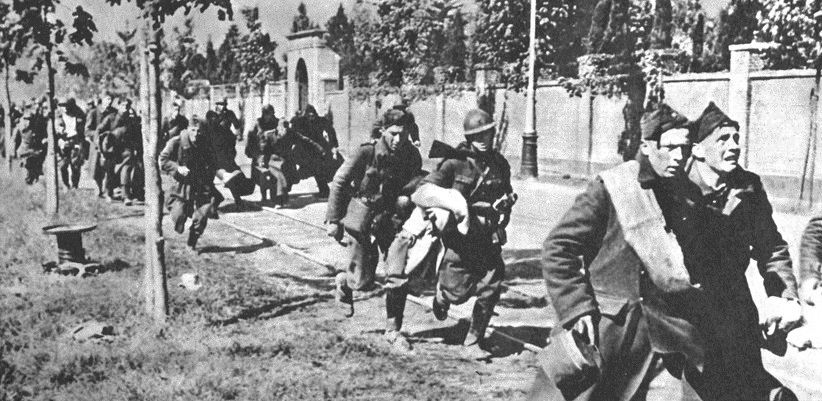
Terrified French troops flee from Heerenveen
The Belgians were able to get away from a probe into Turnhout with only slight losses. Normally I might have been a little annoyed that we did not inflict more casualties, but the news from Hasselt was far too exciting.
It had been bloody, but General von Faber du Faur had taken his orders literally. Failure was not an option. He had flung battalion after battalion across the Maas, regardless of the cost. With his heart steeled against the pleas of his junior officers, he had dismissed the casualty lists and moved up fresh units. Now he could report that Hasselt was ours.

Waiting their turn to cross the Maas, our soldiers take advantage of any cover
That was all I needed. Rotklee II would be put into action. I spent the afternoon sending a few memos and dropped in for a moment with the Führer to discuss a few meetings he was disinclined to attend. The seeds had been planted; now I had to wait for germination.
As night fell, General von Pfeffer-Wildenbruch was under attack in Heerenven, General Cartier having managed to rally his two French divisions. (The Dutch and the other French division were still heading west according to our observers). Von Manstein was already sending reinforcements to back up Liebstandarte SS “Adolf Hitler”, though it looked as though they were holding their ground.
Goebbels had another surprise for the Reich on Saturday. Actually, it was a surprise for the world when Reichssender Hamburg started broadcasting a short program using a collection of English speaking announcers. The English were quite annoyed and refer to the broadcasts as those of “Lord Haw-Haw”. One announcer in particular attracts their anger – a Mr William Joyce from America. The broadcasts are only medium wave but I understand Goebbels is planning a short wave program aimed at the USA. It may not do much good, but it does keep Goebbels from looking too closely at the Reichskanzlei and certain strange orders.
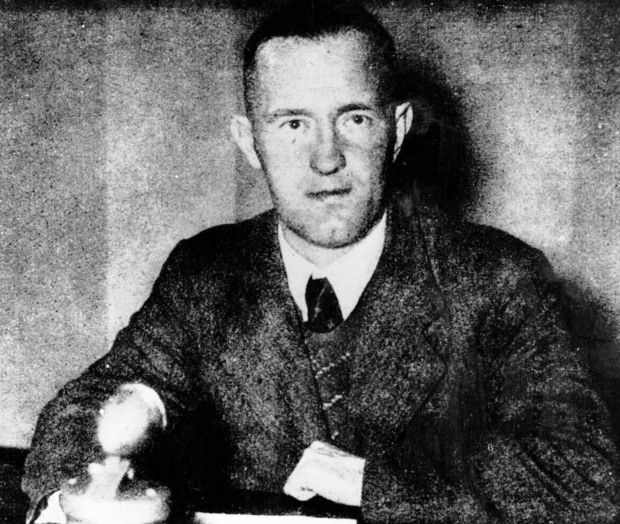
William Joyce broadcasts to the British Isles: Lord Haw-Haw is born
Administratively, some improvements were made in our artillery unit command and control, but we still have no capacity to increase our research. Recent changes are still being digested. That is not good, but at least it allowed plenty of time for my hints and suggestions to work. Early on the 3rd the first steps were taken. At 1AM an order was issued from OKW to 1st Panzerarmee: the attack on Sedan must be cancelled. Within an hour fighting had ceased, and we could count the cost. More than 1,000 dead and we had gained nothing.
Rommel was still focussing on his left flank however. 3(Mot)ID was ordered to take Sarreguinnes. Even from Berlin we could see the futility of this: 19,000 men against 5 full divisions sitting in well fortified positions! Luckily reason prevailed soon after the attack began: von Falkenhorst probably took matters into his own hands, not wishing to see his division sacrificed for Rommel’s sake.
At 4AM a more acceptable move by 1st Panzerarmee. General Thiessen advanced into Philippeville, held by a single Belgian division, 2ème Division d’Infanterie. I would have expected Thiessen to have been given a few extra divisions, but 3.ID (mot) has more than two to one superiority in numbers. At least Rommel is looking to his right.
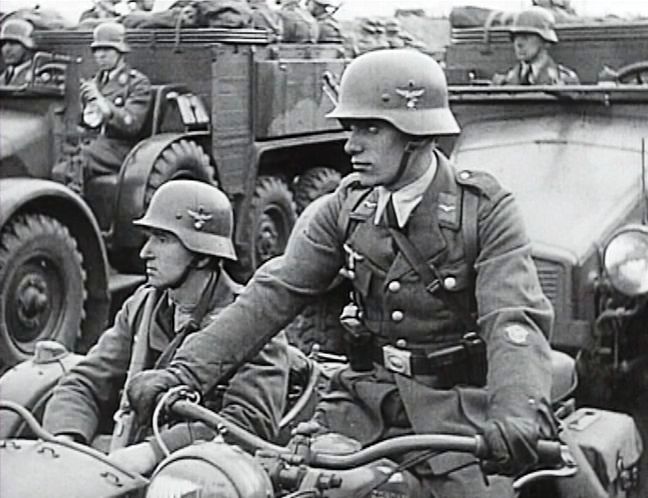
On the move – 3.ID (mot) heads into combat. These neat uniforms are about to get dirty.
Rommel is not the only lunatic around; the French also squandered lives needlessly. Someone in the French high Command decided to test our defences in Saarbrucken. 55e Division d’Infanterie marched into the guns of 69.ID and Kampfgruppe “Kempf”. In a mere two hours three hundred French soldiers were killed, while we lost not one man. A sterling display of what a prepared defence could do to an ill-advised attack. And what did Rommel do? Ordered Kempf to take his kampfgruppe into Sarreguinnes! Only hours after von Falkenhorst had shown how pointless such an attack was! Another 50 men dead before Kempf could withdraw without making it plain what he thought of such orders.
The Kriegmarine was not risking our U-boats on such risky attacks. All commanders are under orders to act with caution: not defensively, but not aggressively either. So when a convoy is too well protected, it is left alone. Unless, of course, an escort presents too tempting a target to resist. That is Arnauld de la Periere’s reason for sinking a Dutch escort, an Admirelen class destroyer. These lack any real anti-submarine capability (they even have to lower their scout-planes into the water), and their use as escorts is a sign of the concern we are causing.

A long trail of smoke drifts from the stricken destroyer, as our submarines retreat to look for another target.
In spite of the restriction in research funding, our project teams were still performing wonders. A more effective training program for submarine crews is now in place, and an excellent study of Divisional HQ administration promises to cut delays between attacks by up to 6 hours! Both these projects will have an immediate impact. Unfortunately, we cannot continue either: there is still a queue of projects waiting to be started.
People were starting to ask questions about Rommel on the 4th February. Has he lost his objectiveness? Has he a fixation on crossing the Meuse? There must be some reason for his decision to again send Neuling and the cream of 1st Panzerarmee against General Adam and his combined French/Dutch/British corps in Sedan. It does force the Allies to keep considerable troops east of our schwerpunkt, but at the cost of five of our best divisions.
In Betuwe, von Manstein showed that crossing a river under fire can be done, but the price he paid was considerable. As he pointed out, however, he had something to show after the battle, other than a list of dead and missing. Niedersachsen Armee had troops within 50 kilometres of Rotterdam, and had broken one of the most important defence lines in Holland.
I had wondered whether my Werner had taken up my hint regarding Verviers. At noon on Monday, he rang with excitement in his voice. “We are attacking Liège!” he yelled over the crash of guns and explosions. “You would not believe the excitement. Just rang to thank you for the tip – must go – have to catch up with Gretchen”. The phone went dead.
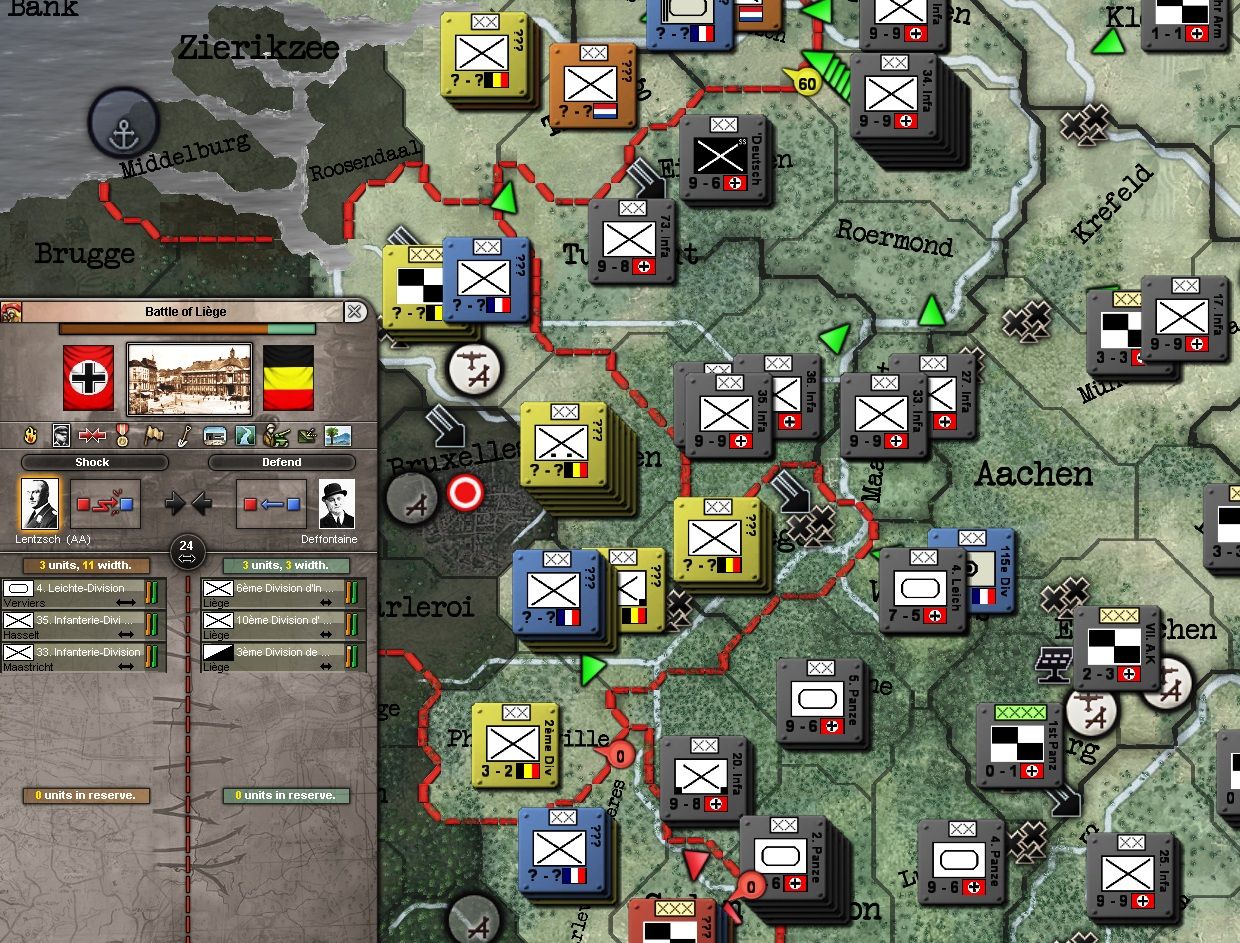
Battle of Liège: 5th February 1940
When I had dropped the suggestion, I hadn’t intended that my two trainee Signal reporters would be anywhere near the front, let alone join in the attack. I had envisioned the two sitting well in the rear, perhaps going to an observation post when it was safe enough. Well, if anything happens, I hope they are both unrecognisable. Nothing to trace them back to me. Not that I wish them harm, just if they get themselves killed, there is no need for me to go too.
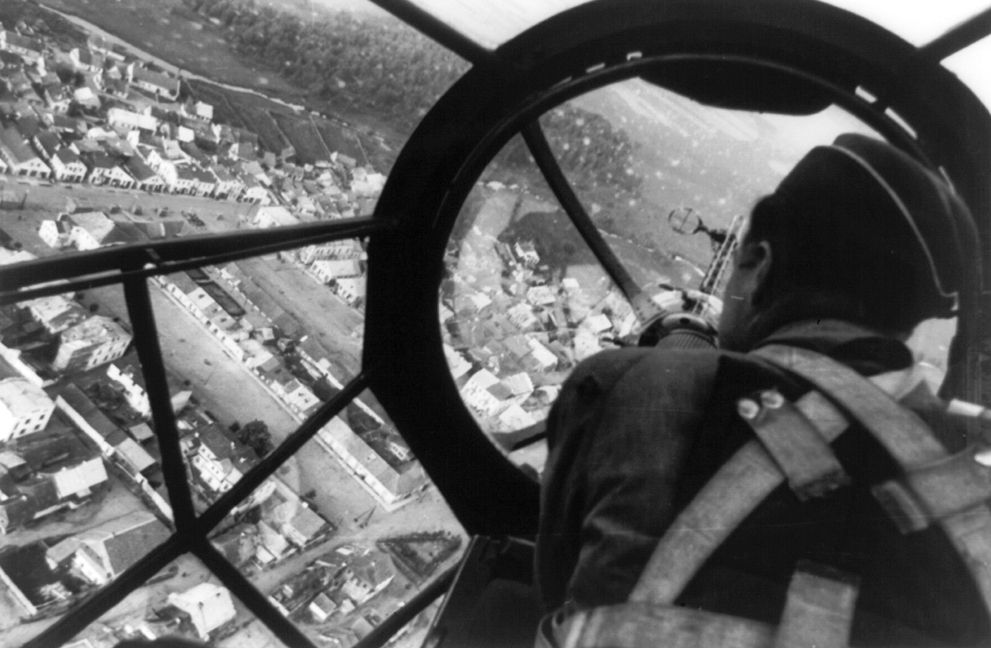
The view from a Heinkel of Luftflotte II over Liège: this could be the scene of the breakthrough Rommel needs
As well as Liège, fighting started at Dokkum on the Frisian Coast. Kortzfleische had an opportunity to ease his division into combat, taking on a single French division on the flat coastal terrain. 45.ID will no doubt benefit from the experience, but it is hardly a tough fight.
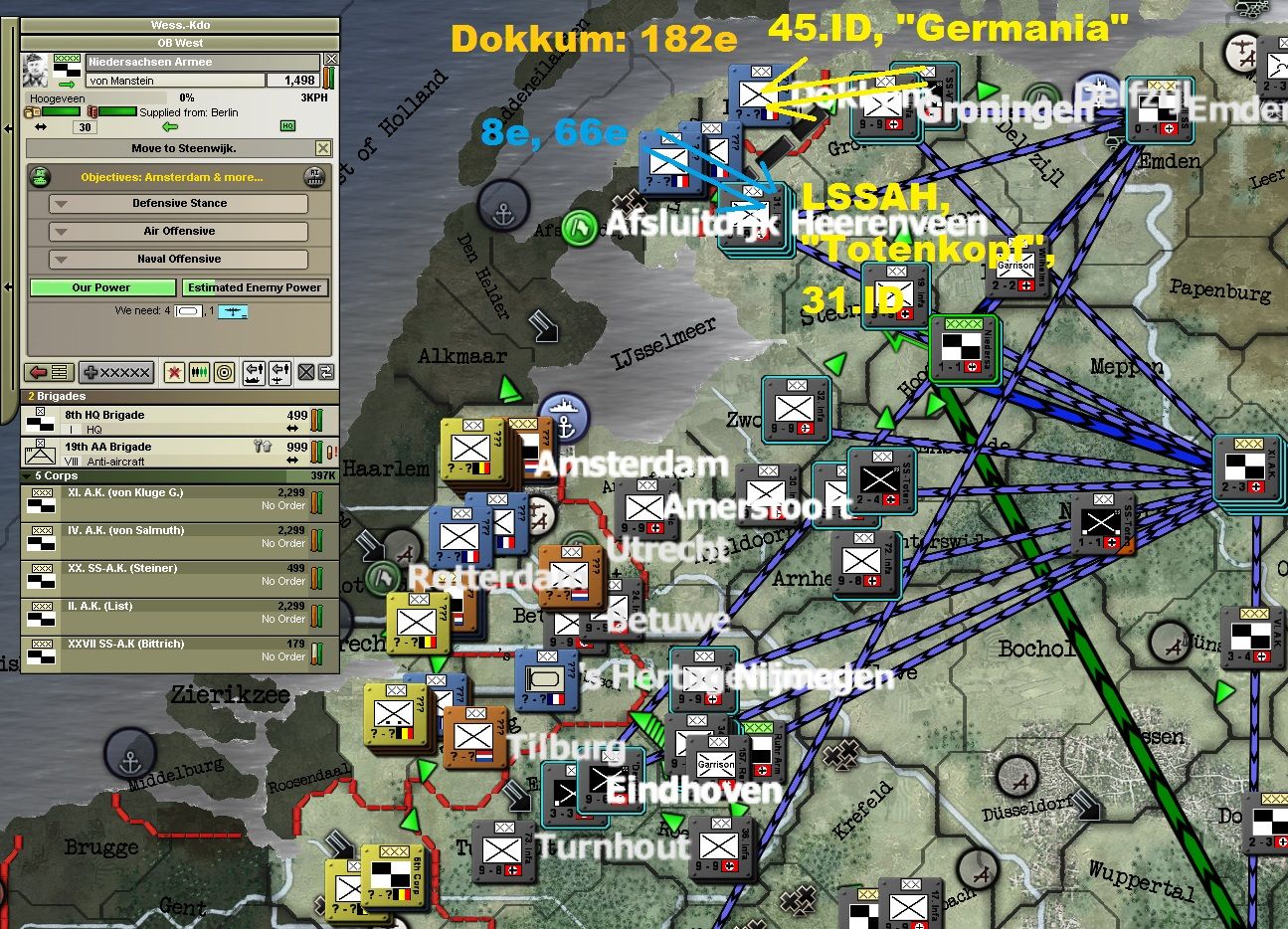
Niedersachsen Armee at end of 7th February 1940
As fighting continued at Liège, the victors of the Battle of Hasselt swept forward into Leuven. To defend his province, General Michiels had six divisions but many were smaller cavalry units. General Kirchner had only 8.PzD and 10.ID, but that seemed to be enough to push forward to the suburbs of Bruxelles. Things were looking up.
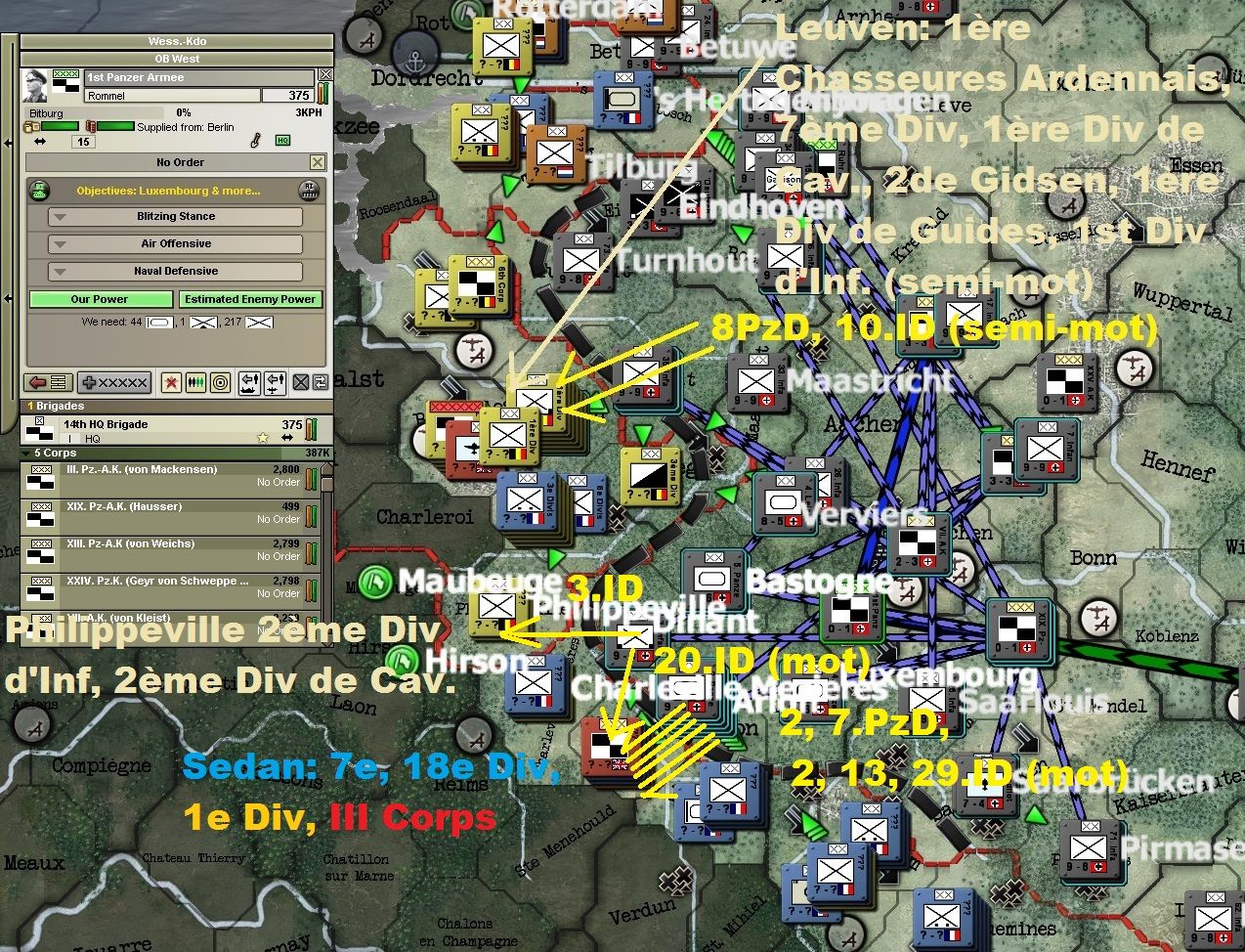
1st Panzerarmee at end of 7th February 1940
Although another research project was completed, we were still unable to commence anything new. This lack of leadership material is starting to be a real problem. There are dozens of eligible projects that would be of great assistance to the war effort. For example, the latest success in torpedo design would allow us to research a completely new acoustic torpedo, something that would give our U-boats a distinct advantage. Long range plans to increase the number of young engineers and scientists are being considered: a new university system is a possibility.
No news from Werner on Wednesday. I’m not sure if that is good or bad. The Battle for Liège continues, with Dessloch’s bombers hitting the city three times. In fact the Luftwaffe was very active that day, a total of 12 bombing raids carried out. And no interference for a change: the sacrifice of the fighter pilots has paid off.

Ruhr Armee at end of 7th February 1940
It was a good thing that our flyers were active as little happened on the ground on 7th February. Seven battles still raged with no indication whether the Wehrmacht might make a decisive breakthrough. And no word from my rash and impulsive agent and his apparently equally rash and impulsive fotografieren friend. Let us hope that both they and Unternehmen Glückslee are doing well.
There is no more I can. It is out of my hands. I may as well take advantage of some winter sun and go for a walk.
You have given up worrying about who the man is. Had you kept watching, you would have noticed a few things about him. He is constantly alert, looking at every person and event around him. He has a semi-military posture, but unlike most of the men of his age on the streets around here, he is not in uniform. No sign of injury. His clothes indicate he is well off – his coat in particular would have cost a week’s wages.
But you have just assumed he is another middle-aged bureaucrat having a spell from his desk.
That is what you are supposed to think. As you hurry on, your mind full of other thoughts, the man who pulls the strings in the Reichskanzlerie continues with his walk, busily making plans that will impact you and your family for years to come.
Code:
[B]Finalised Battles for the period 1st to 7th February 1940[/B]
Steenwijk 1,836 (72,292) 386 (29,286) [F258/D128]
Heerenveen 177 (120,313) 2,664 (60,431) [F1,998/D666]
Turnhout 4 (24,480) 11 (24,262) [B]
Hasselt 1,753 (106,934) 249 (49,928) [B]
Sedan 1,175 (108,715) 121 (91,494) [UK40/F64/D17]
Sarreguinnes 64 (18,992) 0 (94,098) [F]
2nd Sarreguinnes 50 (12,288) 0 (93,741) [F]
Saarbrücken 0 (32,277) 300 (19,492) [F]
Betuwe 3,481 (181,882) 4,056 (103,662) [D2,434/F1,622]
French 4,242
Belgian 260
Dutch 3,245
British 40
Total [B]8,540[/B] [B]7,787[/B]
[B]Bombing Summary for the period 1st to 7th February 1940[/B]
[I]Luftwaffe[/I]
Hasselt Luftflotte II 12, 3 (15) [B]
SLF I + LF II 50, 29 (79) [B]
Sedan Schlachtluftflotte II 22, 18, 47, 24, 39 (150)
SLF II + V 46, 92 (138)
LF III 25, 11, 41, 31 (108)
LF VII 13, 30, 8 (51)
Total 447 [UK149/D59/F239]
‘s Hertogenbosch LF VII 23, 3, 4, 26 (56)
SLF V 14, 31 (45)
Total 100 [F67/D34]
Philippeville SLF II 25, 24, 27, 53, 40 (169) [B]
SLF II + V 14, 75, 44, 46 (179)
SLF V 21, 59, 35 (115)
Liege LF II 6, 38, 18 (62) [B]
Leuven SLF II 33, 20, 14 (67) [B]
French 306
Belgian 686
Dutch 93
British 149
Total [B]1,234[/B]
[I]L’Armee de l’Air[/I]
Dinant Laurens (TAC) 8, 3
Odic (2 x TAC, NAV) 20
[I]Belgian Air Force[/I]
Hasselt Wouters (2 x TAC) 0, 14, Abort
Total [B]45[/B]
[B][SIZE=4]Unternehmen Glückslee[/SIZE][/B]
Unternhemen Glücksklee German Losses 8,540 (Ground) + 45 (Bombing) = 8,585
Unternehmen Glücksklee French Losses 4,242 + 306 = 4,548
Unternehmen Glücksklee Belgian Losses 260 + 686 = 946
Unternehmen Glücksklee Dutch Losses 3,245 + 93 = 3,338
Unternehmen Glücksklee Lux. Losses Nil + Nil = Nil
Unternehmen Glückslee British Losses 40 + 149 = 189
Total 7,787 + 1,234 = 9,021
[B]Unternehmen Glücksklee Cumulative Losses[/B]
German Ground Losses 8,540 + 28,168 = 36,708
German Bombing Losses 45 + 357 = 402
German Total Losses 8,585 + 28,525 = 37,110
French Ground Losses 4,242 + 33,706 = 37,948
French Bombing Losses 306 + 3,350 = 3,656
French Total Losses 4,548 + 37,056 = 41,604
Belgian Ground Losses 260 + 10,364 = 10,624
Belgian Bombing Losses 686 + 4,394 = 5,080
Belgian Total Losses 946 + 14,758 = 15,704
Dutch Ground Losses 3,245 + 8,418 = 11,663
Dutch Bombing Losses 93 + 5,137 = 5,230
Dutch Total Losses 3,338 + 13,555 = 16,893
Lux. Ground Losses Nil + 1,148 = 1,148
Lux. Bombing Losses Nil + 159 = 159
Lux. Total Losses Nil + 1,307 = 1,307
British Ground Losses 40 + 146 = 186
British Bombing Losses 149 + 464 = 613
Total British Losses 189 + 610 = 799
Allied Ground Losses 37,948 + 10,624 + 11,663 + 1,148 + 186 = 61,569
Allied Bombing Losses 3,656 + 5,080 + 5,230 + 159 + 613 = 14,738
Total Allied Losses 41,604 + 15,704 + 16,893 + 1,307 + 799 = 76,307
[B][SIZE=4]Overall Casualties to date[/SIZE][/B]
German Fall Weiß 72,527 + 1,587 = 74,114
Westwall 3,490 + 2,571 = 6,061
Unternehmen Glücksklee 36,708 + 402 = 37,110
Total German Losses 112,725 + 4,560 = 117,285
Polish Losses Fall Weiß 126,753 + 42,856 = 169,609
French Losses Westwall 15,285 + Nil = 15,285
Glücksklee 37,948 + 3,656 = 41,604
Total French Losses 53,233 + 3,656 = 56,889
Belgian Losses Glücksklee 10,624 + 5,080 = 15,704
Dutch Losses Glücksklee 11,663 + 5,230 = 16,893
Lux. Losses Glückslee 1,148 + 159 = 1,307
British Losses Westwall 887 + Nil = 887
Glücksklee 186 + 613 = 799
Total British Losses 1,073 + 613 = 1,686
Total Allied Losses 169,609 + 56,889 + 15,704 + 16,893 + 1,307 + 1,686 = 262,088
[B][SIZE=4]War at Sea[/SIZE][/B]
Current Prior Total
U-boat losses Nil 2 2
Convoy losses French Nil 5 5
British Nil 5 5
Canadian Nil 1 1
Dutch Nil 3 3
New Zealand Nil 1 1
Total Allied Nil 15 15
German Nil 4 4
Escort losses British Nil 1 1
Dutch 1 Nil 1
[B]Warship Losses[/B]
Destroyer British Nil 1 1
German Nil 1 1
Light Cruiser German Nil 1 1
British Nil 1 1
Last edited:

